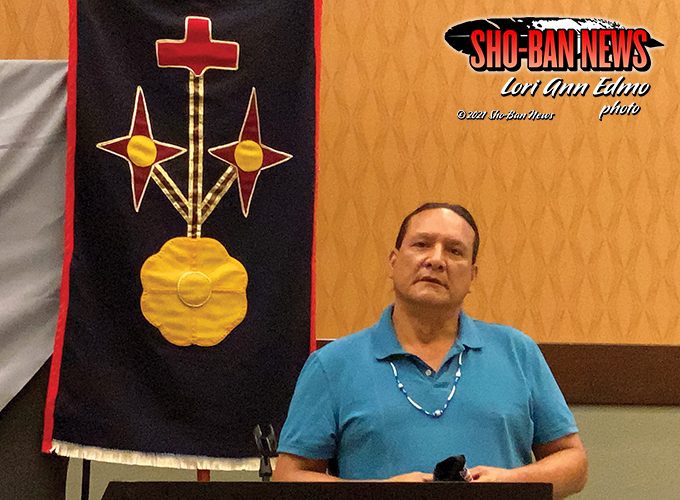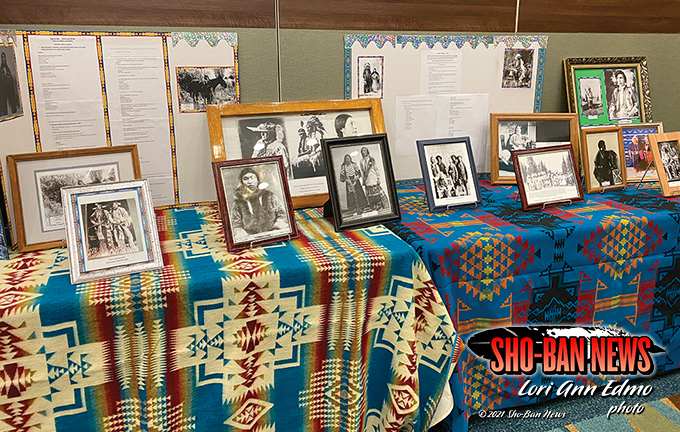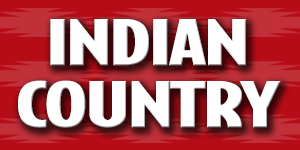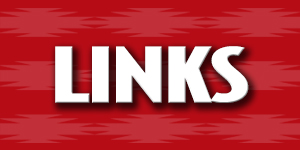Bannock Gathering emphasizes language & history of its people

FHBC Chairman Devon Boyer speaks in front of the Bannock flag.
By LORI ANN EDMO
Sho-Ban News
FORT HALL — Emphasis to retain the Bannock language and remembering Bannocks who made a difference was the message as the Bannock Gathering was conducted at the Shoshone-Bannock Hotel Events Center August 9.
Fort Hall Business Council Chairman Devon Boyer encouraged attendees to do their best to protect themselves and be careful because of the delta variant. “It’s devastating our world and we have to keep fighting, protecting and help each other out.” He appreciated the Gathering was available on Zoom to keep Panakwates together wherever they are. He used to hear stories a long time ago – the Bannock are the ones who held the road, took care of a lot of things, “There’s a lot of things to be proud of, we have a treaty with U.S. government,” that encompassed all the Bannocks did, where we roamed, hunted, fished and gathered, on the unoccupied lands. He thanked each and every one for participating.
The Horse
Tribal archivist Velda Racehorse did a PowerPoint presentation on the Bannock Chiefs. The first one she noted was “The Horse” who led from 1794 to 1832. He led an attack on the Astorian fur posed commanded by John Reed on the lower Boise River that because of white encroachment — buffalo were disappearing from the valleys in the Ochoco in central Oregon. In the mid-1820s the Hudson Bay Company had a full fur trading operation in British Columbia, Montana, Idaho, Washington, Oregon, Utah, Nevada and California. Many Shoshone-Bannocks joined forces with the Blackfeet tribes to fight against the fur companies. There was a report from a mountain man Jim Beckwourth who said some Bannock opened fire on three trappers killing one so Jim Bridger and 215 volunteers retaliated. Chief Horse’s people numbered 1500 strong and traveled from the Ochoco to the Camas Prairie. A British trader Peter Ogden gave weapons in exchange for 50 beaver pelts to Chief Horse. Ogden’s Shoshone guide was killed by a Cayuse brave so after that word spread that foreigners white or red would be killed if they entered Shoshone hunting grounds. During a hunt, a battle occurred between the Blackfeet and Chief Horse’s war party – The Horse was killed in the Salmon River country. Later the Chiefs’ wife Little Striped Squirrel gave birth to his son “Chochoco” – Has No Horse.
Le Grand Coquin
From 1832 to 1865 Le Grand Coquin became chief of the Bannocks. He was called Aro roka kee, the Bannock Chief was given the name LeGrand Coquin by Captain Grant that means the “Big Rogue,” in French. He also went by the name “To’sobwanbenaht” and his name was identified on the 1863 Treaty of Soda Springs. He was reported to stand 6 foot two inches weighing 275 pounds. Racehorse showed a map of the territory where he roamed in what was later known as Idaho, Oregon, California and Nevada. In 1860 two large groups of Bannocks formed – one led by Chief Mopeah and the other by Chief LeGrand Coquin. He was a signer of the unratified Treaty of Soda Springs in Idaho. Coquin died in 1865 then Taghee became the chief.

Display table at the Bannock Gathering Monday, August 9.
Taghee
Taghee was a war chief who served under Bannock Chief Le Grand Coquin but became the leader after Coquin passed. On October 14, 1863, James D. Doty negotiated a treaty of peace and friendship with the mixed bands of Fort Hall Bannock and Shoshone at Soda Springs, Idaho Territory. It was suggested Taghee share the Wind River Reservation with Chief Washakie’s band but Taghee declined, “As far away as Virginia City, Mont. our tribe has roamed but I want the Porte Nuef country and the Kamas plains. We are friends with the Shoshones and like to hunt with them but we want a home for ourselves.” (notation from Brigham Madsen’s book.) Chief Taghee was one of the Bannock chiefs to sign the unratified treaty at Soda Springs. He discovered the white men weren’t upholding their obligations under the peace treaty settlements. In 1864, supplies didn’t arrive and scalp hunters were getting $25 to $100 for an Indian scalp according to Brigham Madsen’s book Bannocks of Idaho. In 1867, the U.S. President established the Fort Hall Reservation by executive order intended for Bannock but included other Indians. In the meantime, Chief Taghee met with Governor D.W. Ballard at Long Tom Creek near the Camas Prairie to negotiate a different treaty. It was unratified. On July 3, 1868, General C.C. Auger negotiates a treaty with the Snakes and Bannocks, along with Eastern Shoshone under Chief Washakie at Fort Bridger, Wyo. Taghee was the principal signer to the treaty that was ratified by the U.S. Congress. After the treaty was signed Taghee’s request for (Kamas Plains) Camas Prairie was eliminated because of a spelling error.
In the summer of 1870, Taghee threatened to wage war because no supplies were delivered to Fort Hall. An immediate partial distribution was supplied. After the Indians were moved to the Fort Hall Reservation, Taghee left his Bannock Chief status to his son Pat then left for buffalo country in Montana where he died in 1871.
Buffalo Horn
Buffalo Horn was born in Oregon and died in Idaho. He was born to Paiute parents but later was called Bannock in Fort Hall. In 1877 he was an Indian scout for General Howard of the U.S. Army. In 1878 he and some other Bannocks were involved in a raid coming from Wyoming to Oregon. He was involved in the Bannock War that started after settlers pigs were digging up camas roots on the Camas Prairie. The Bannocks were in many battles and Buffalo Horn didn’t return to the Fort Hall Reservation as he was injured in a battle and died from it. His body was never found although a researcher said he met an ancient Indian in Pocatello who claimed to be Buffalo Horn. A Mrs. Blakeslee who said she was one of his cousins said Buffalo Horn didn’t die at South Mountain but escaped and went to Wyoming. She said he had a bullet in his spine and suffered before recovering. It was reported he is buried in a graveyard known as the Hill of Humans on the Fort Hall Reservation but they’re unmarked and unidentified.
Digital archive
Following the Chiefs presentation Bannock language apprentice Dillin Diggie did a presentation on creating a digital archive through showing a Bannock story Lizzie Randall Edmo told about two Bannock girls that were stolen and one eventually returned to her family escaping from the Blackfeet on horse. The story is from a tape Swedish linguist Sven Lljeblad recorded in 1951 and was transcribed by Bannock teachers Zelphia Towersap and Daisy Dixey. The Bannock words (much of it in older version of the language) was shown on the screen while Edmo’s audio was played. Diggie explained the story in English after it was told in Bannock.
After lunch a video of tribal elder Floyvan Coby was shown and he talked about his father the late Keno Yambasi Coby and White Horse Coby. He said Idaho was Bannock Country and there were camps all over. White Horse he was down Bottoms, they were short of horses, he decided to go to Montana and steal horses. He ended up staying there for a while and had a family. One of his daughters made it back to Wyoming who eventually ended up among the Utes. That’s how they have family there.
Floyvan also talked about his father got involved in Indian relay racing and obtained horses from Toma Pokibro – he had a lot of horses. That’s how he started in Indian relay. They took their team, tipi poles, food to the fair. They camped there, 150 tipis at the fairgrounds. He said there was rubber stretched across the fairgrounds, when the race started the rubber broke and hit him in the eye, he still won. How he lost his eyesight in one eye. Yambasi went to Indian relay races all over even to Pendleton, Oregon. There was a lot of Edmo’s there – bronc riders. He beat them over there too. He went to town to get presents when he got back two guys tried to jump him and steal his money. Yambasi has good horses. Floyvan said White Horse is buried at Sandhill right next to his dad.

Video showing Floyvan Coby telling oral history about his father Keno Yambasi Coby Jr. and
White Horse Coby at the gathering.
Bannock Zoom classes
Next up Dillin Diggie shared videos of Bannock language students who introduced themselves in the language and also in person. Tribal members who live out of state are taking classes and learning.
Louise E. Dixey, LCPD director did a presentation on preparing toishavui (chokecherries) followed by Panakwate Jeopardy that Dillin Diggie hosted. Participants selected a category and responded in the form of a question. Tyree Smith won first, Lori Edmo second and Nolan Brown third.
Participants who registered were given Bannock Gathering T shirts that featured artwork created by Burdett Osborne.
The Bannock Gathering began in 2006 to remind everyone that preserving the Bannock language is essential to our existence – the language helps to identify us as Bannock and as a people.





